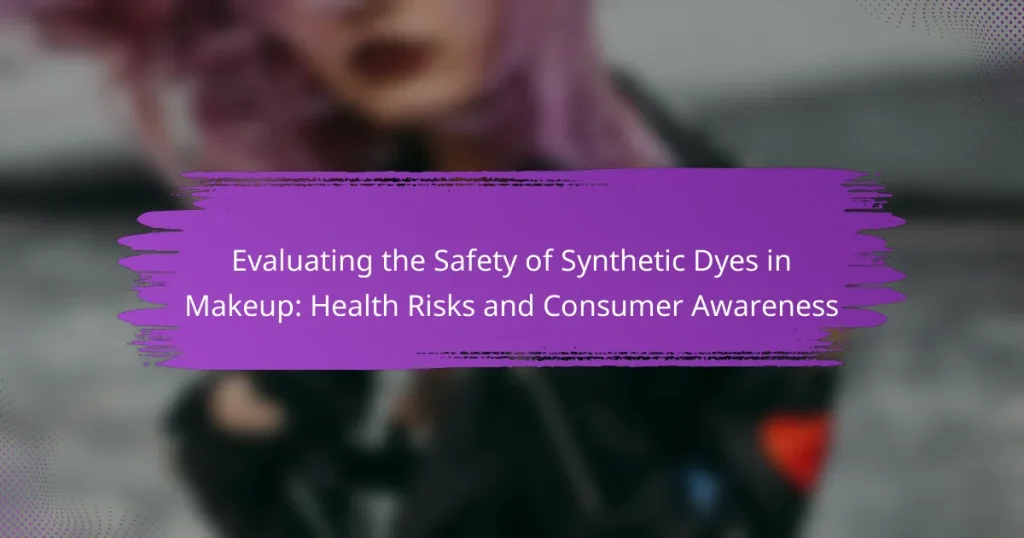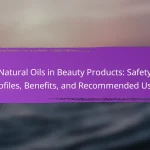Synthetic dyes are artificial colorants used in makeup to enhance the appearance of cosmetic products such as foundations, lipsticks, and eyeshadows. These dyes are regulated by the Food and Drug Administration (FDA) in the United States, which ensures their safety and effectiveness through strict criteria and labeling requirements. While synthetic dyes provide vivid colors and consistency, some individuals may experience allergic reactions, highlighting the need for consumer awareness. Additionally, natural pigments derived from plants and minerals offer safer alternatives, aligning with the growing demand for clean beauty products. This article evaluates the safety of synthetic dyes in makeup, addressing health risks and the importance of informed consumer choices.
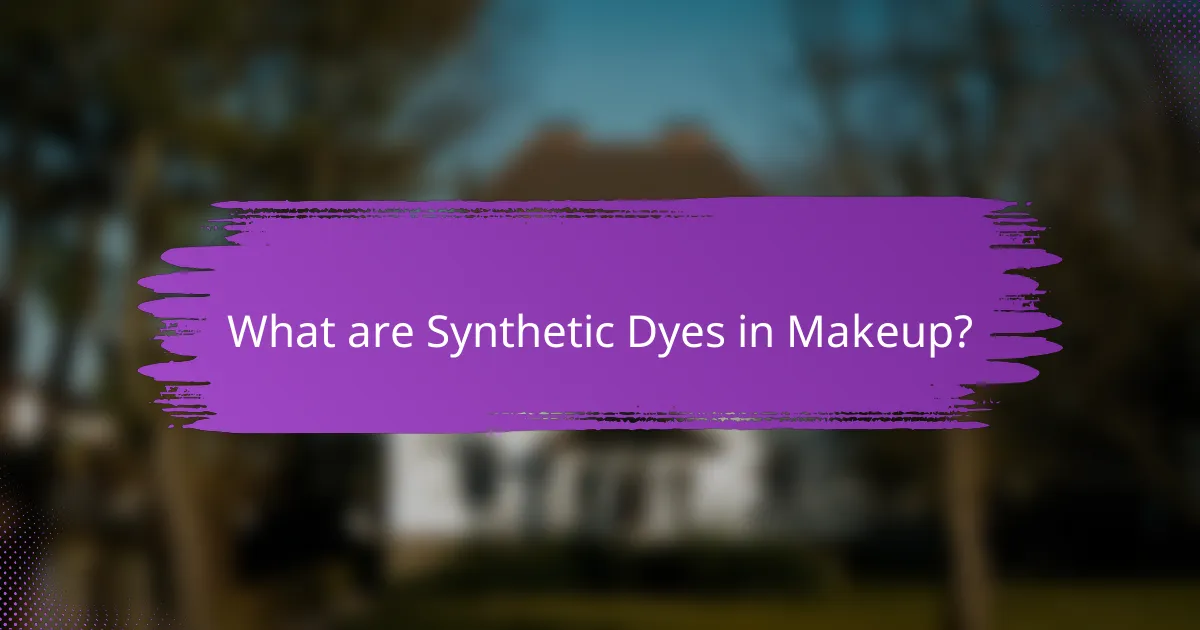
What are Synthetic Dyes in Makeup?
Synthetic dyes in makeup are artificial colorants used to enhance the appearance of cosmetic products. These dyes are created through chemical processes and can provide vivid colors that natural dyes may not achieve. Synthetic dyes are commonly used in foundations, lipsticks, and eyeshadows. They are often preferred for their stability and consistency in color. Many synthetic dyes are regulated by agencies such as the FDA. This regulation ensures their safety for consumer use. However, some individuals may experience allergic reactions to specific synthetic dyes. Awareness of these potential risks is crucial for informed consumer choices.
How are Synthetic Dyes Used in Cosmetic Products?
Synthetic dyes are used in cosmetic products to provide color and enhance visual appeal. These dyes are formulated to be stable and long-lasting, ensuring that the color remains vibrant throughout the product’s use. They are commonly found in items like lipsticks, eyeshadows, and nail polishes.
The use of synthetic dyes allows for a wider range of colors compared to natural alternatives. This versatility meets consumer demand for diverse cosmetic shades. Additionally, synthetic dyes can be produced consistently in large quantities, ensuring uniformity in products.
Regulatory bodies, such as the FDA, regulate the use of specific synthetic dyes in cosmetics. These regulations ensure that only approved dyes are used, minimizing potential health risks. Studies have shown that some synthetic dyes may cause allergic reactions in sensitive individuals. Therefore, manufacturers often include information about these dyes on product labels.
Overall, synthetic dyes play a crucial role in the cosmetic industry by providing desired colors while adhering to safety standards.
What Types of Synthetic Dyes Are Commonly Found in Makeup?
Common types of synthetic dyes found in makeup include FD&C dyes, D&C dyes, and lake dyes. FD&C dyes are approved for use in food, drugs, and cosmetics. They are often labeled with a number and “FD&C,” such as FD&C Red No. 40. D&C dyes are restricted to use in drugs and cosmetics only. They also have a number and “D&C” designation, like D&C Yellow No. 5. Lake dyes are pigments created by combining FD&C or D&C dyes with a substrate, allowing for better stability in formulations. These synthetic dyes are widely used for their vibrant colors and consistency in products.
What Functions Do Synthetic Dyes Serve in Cosmetics?
Synthetic dyes serve multiple functions in cosmetics. They provide color to products, enhancing visual appeal. These dyes allow for a wide range of hues, enabling brands to create unique shades. Synthetic dyes also contribute to product consistency, ensuring uniformity across batches. Additionally, they can improve the overall aesthetic experience for consumers. Some synthetic dyes have specific qualities, such as being more stable under light and heat. This stability helps maintain the product’s appearance over time. Furthermore, synthetic dyes can be formulated to be more vibrant than natural alternatives. This vibrancy can attract consumers seeking bold makeup options.
What are the Potential Health Risks Associated with Synthetic Dyes?
Synthetic dyes can pose several health risks. Some synthetic dyes are linked to allergic reactions. These reactions may manifest as skin irritation or rashes. Certain dyes have been associated with more serious health concerns. For instance, some studies suggest a connection to hyperactivity in children. The Center for Science in the Public Interest reported that specific dyes could trigger behavioral issues. Additionally, some synthetic dyes may contain carcinogenic compounds. Research has indicated that long-term exposure may increase cancer risk. Regulatory agencies have banned certain hazardous dyes due to these concerns. The FDA monitors synthetic dye safety, but risks remain for some individuals.
How Can Synthetic Dyes Affect Skin Health?
Synthetic dyes can negatively impact skin health by causing allergic reactions and irritation. These dyes may lead to contact dermatitis, characterized by redness, itching, and swelling. Studies show that certain synthetic dyes can provoke skin sensitivities in vulnerable individuals. For example, the European Commission has identified some dyes as potential allergens. Additionally, prolonged exposure to synthetic dyes can disrupt the skin’s natural barrier. This disruption can increase susceptibility to infections and other skin conditions. Therefore, consumers should be cautious when using products containing synthetic dyes.
What Allergic Reactions Can Synthetic Dyes Trigger?
Synthetic dyes can trigger various allergic reactions, including skin irritation, rashes, and hives. These reactions occur due to the body’s immune response to certain chemical compounds in the dyes. Symptoms may include redness, swelling, and itching at the site of contact. In some cases, individuals may experience more severe reactions, such as anaphylaxis, although this is rare. Studies have shown that synthetic dyes, particularly those derived from coal tar, can cause sensitization in some individuals. For example, the FDA has reported that certain food colorings can lead to allergic reactions in susceptible populations. Therefore, consumers with known sensitivities should exercise caution when using products containing synthetic dyes.
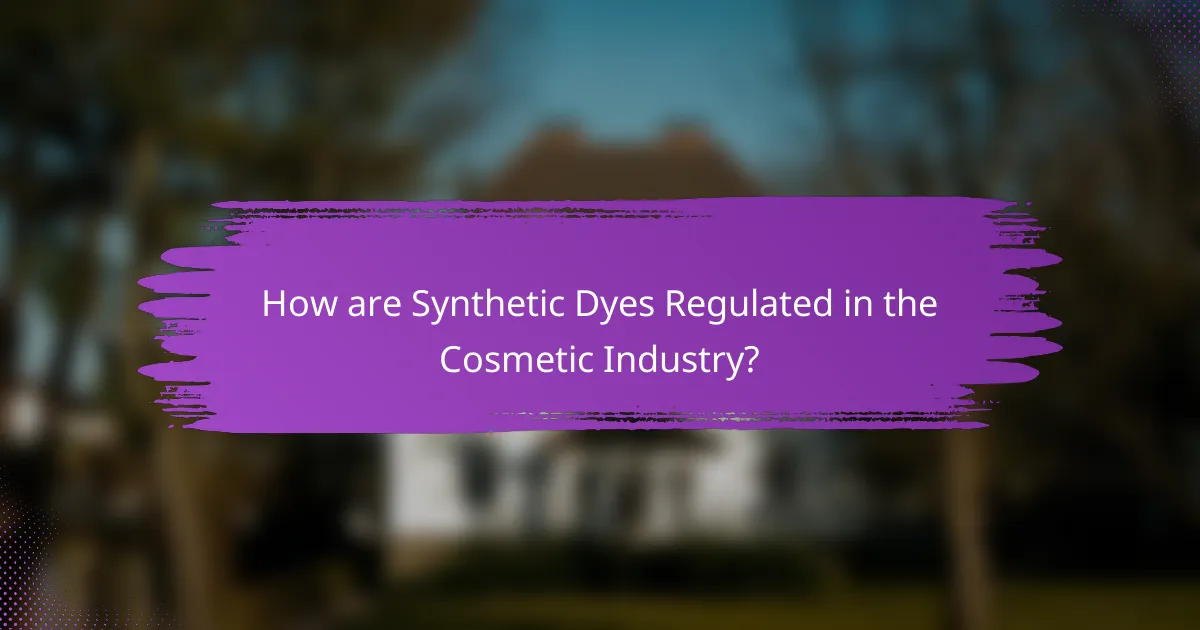
How are Synthetic Dyes Regulated in the Cosmetic Industry?
Synthetic dyes in the cosmetic industry are regulated primarily by the Food and Drug Administration (FDA) in the United States. The FDA requires that synthetic dyes used in cosmetics be approved for safety and effectiveness. These dyes must meet specific criteria outlined in the Federal Food, Drug, and Cosmetic Act. Manufacturers must provide evidence of safety for each dye before it can be used in cosmetics. The FDA maintains a list of approved color additives that includes synthetic dyes. Additionally, the regulations specify labeling requirements for products containing these dyes. This ensures transparency and consumer awareness regarding the ingredients used in cosmetics. Regular inspections and compliance checks are conducted to enforce these regulations.
What Standards Govern the Use of Synthetic Dyes in Makeup?
The use of synthetic dyes in makeup is governed by regulations set forth by the FDA in the United States. The FDA categorizes these dyes as Color Additives and requires pre-market approval for safety. Each synthetic dye must undergo rigorous testing to ensure it does not pose health risks. Additionally, the European Union has its own regulations under the Cosmetics Regulation (EC) No. 1223/2009, which also mandates safety assessments. These standards ensure that only safe and approved synthetic dyes are used in cosmetic products. Compliance with these regulations is crucial for manufacturers to ensure consumer safety.
Which Regulatory Bodies Oversee Cosmetic Safety?
The primary regulatory bodies overseeing cosmetic safety include the U.S. Food and Drug Administration (FDA) and the European Commission. The FDA regulates cosmetics under the Federal Food, Drug, and Cosmetic Act. This act mandates that cosmetics must be safe for use and properly labeled. In the European Union, the European Commission enforces the Cosmetics Regulation (EC) No 1223/2009. This regulation ensures that cosmetic products are safe for human health. Both bodies conduct assessments and monitor compliance to protect consumers.
How Do Regulations Vary Across Different Countries?
Regulations regarding synthetic dyes in makeup vary significantly across different countries. In the European Union, the use of certain synthetic dyes is heavily restricted. For example, the EU has banned many harmful dyes and requires safety assessments before approval. In contrast, the United States has a more lenient approach. The FDA allows a wider range of synthetic dyes, though some are still prohibited. Additionally, countries like Canada and Australia have regulations similar to the EU, focusing on consumer safety. These differences reflect varying levels of consumer protection and risk assessment methodologies globally.
What Role Does Consumer Awareness Play in Makeup Safety?
Consumer awareness plays a crucial role in makeup safety. It empowers individuals to make informed choices about products they use. Awareness of harmful ingredients can lead to demand for safer alternatives. For instance, knowledge about synthetic dyes associated with health risks can prompt consumers to seek products without these substances. Studies show that consumers who are informed about potential hazards are more likely to read ingredient labels. According to a survey by the Personal Care Products Council, 70% of consumers check for harmful ingredients before purchasing. Increased awareness can also drive regulatory changes in the cosmetics industry, promoting safer formulations. Ultimately, consumer awareness fosters a culture of safety and accountability among manufacturers.
How Can Consumers Identify Safe Products Containing Synthetic Dyes?
Consumers can identify safe products containing synthetic dyes by checking ingredient labels for specific dye names and numbers. The U.S. Food and Drug Administration (FDA) regulates synthetic dyes, listing approved colors. Consumers should look for dyes marked with “FD&C” or “D&C” followed by a color and number. For example, “FD&C Red No. 40” is a commonly used synthetic dye. Additionally, consumers can research brands that prioritize safety and transparency. Third-party certifications and safety testing can also indicate product reliability. Awareness of potential allergic reactions to certain dyes is crucial. Consumers should consult dermatological studies that highlight safe usage levels of synthetic dyes.
What Resources Are Available for Consumers to Learn About Makeup Ingredients?
Consumers can learn about makeup ingredients through various resources. These include websites like the Environmental Working Group (EWG) and the Personal Care Products Council (PCPC). The EWG provides a database called Skin Deep, which rates cosmetic ingredients based on safety. The PCPC offers information on ingredient safety and regulations. Additionally, the Food and Drug Administration (FDA) provides guidelines on cosmetic labeling and ingredient safety. Books on cosmetic chemistry also serve as educational resources. Online courses about cosmetic formulation can further enhance understanding. Social media platforms and beauty blogs often discuss ingredient safety, offering insights and reviews.
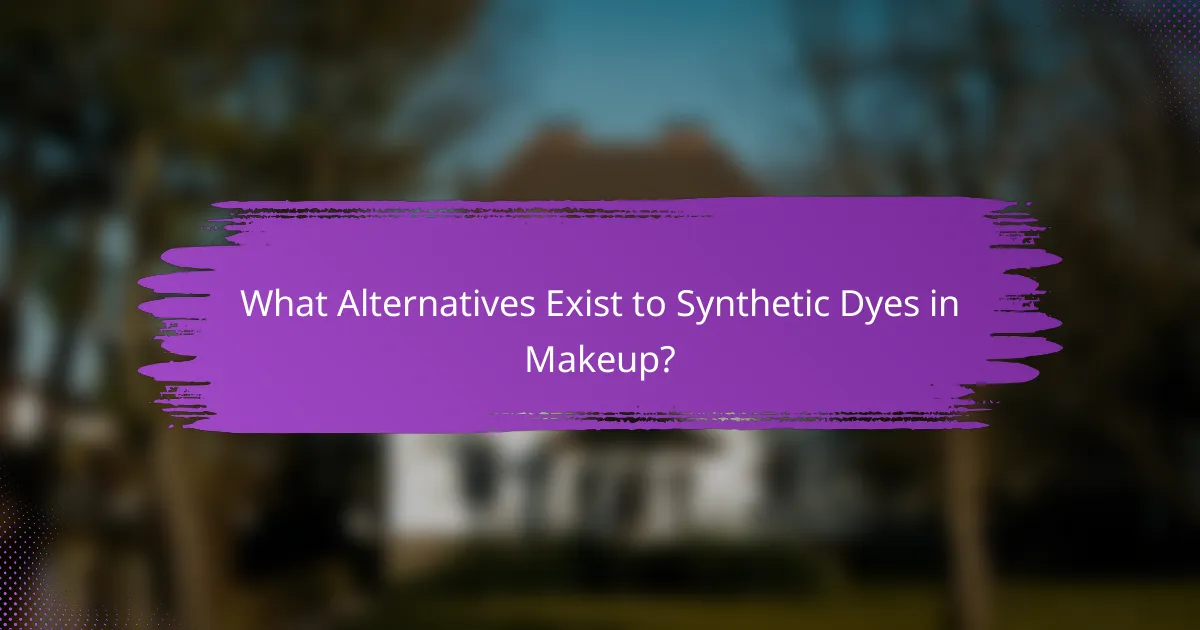
What Alternatives Exist to Synthetic Dyes in Makeup?
Natural pigments serve as effective alternatives to synthetic dyes in makeup. These include plant-based dyes derived from sources like beetroot, turmeric, and spirulina. Additionally, mineral pigments such as iron oxides and mica are commonly used. These alternatives are often considered safer and less likely to cause allergic reactions. Research indicates that natural pigments can provide vibrant colors without harmful chemicals. For instance, beetroot powder can create red hues, while turmeric offers yellow tones. The use of these natural ingredients aligns with the growing consumer demand for clean beauty products.
What Are Natural Dyes, and How Do They Compare to Synthetic Options?
Natural dyes are colorants derived from plants, minerals, or insects. They are used in various applications, including textiles and cosmetics. Natural dyes are often considered safer and more environmentally friendly than synthetic dyes. Synthetic dyes are chemically manufactured and may contain harmful substances. Studies indicate that some synthetic dyes can cause allergic reactions or skin irritation. In contrast, natural dyes typically have fewer side effects. However, natural dyes may fade more quickly and have limited color options. Overall, the choice between natural and synthetic dyes depends on safety, environmental impact, and desired performance.
What Benefits Do Natural Dyes Offer Over Synthetic Dyes?
Natural dyes offer several benefits over synthetic dyes. They are biodegradable and less harmful to the environment. Natural dyes often have fewer allergens, reducing the risk of skin irritation. They can provide a unique color palette that is not achievable with synthetic options. Additionally, natural dyes are derived from renewable resources. Their use supports sustainable farming practices. Studies show that natural dyes can have antimicrobial properties, adding extra benefits. Overall, natural dyes are a safer and eco-friendly alternative to synthetic dyes in makeup.
How Can Consumers Transition to Products with Natural Dyes?
Consumers can transition to products with natural dyes by gradually replacing synthetic options. Start by researching brands that prioritize natural ingredients. Look for certifications or labels indicating natural dye usage. Evaluate ingredient lists to identify products with natural colorants like beetroot or turmeric. Purchase samples to test products before committing to larger quantities. Engage with communities focused on natural beauty for recommendations. Monitor skin reactions to ensure compatibility with natural dyes. This approach allows consumers to make informed choices while minimizing potential health risks associated with synthetic dyes.
What Best Practices Should Consumers Follow When Choosing Makeup Products?
Consumers should prioritize safety and ingredient transparency when choosing makeup products. They should read labels carefully to identify harmful synthetic dyes. Checking for certifications like cruelty-free or organic is essential. Researching brands for their safety practices enhances informed choices. Patch testing new products can prevent adverse reactions. Consumers should also seek products with fewer harmful chemicals. Following these practices minimizes health risks associated with makeup. Studies indicate that awareness of ingredients can lead to safer consumer choices.
How Can Consumers Read Labels Effectively to Avoid Harmful Ingredients?
Consumers can read labels effectively by focusing on ingredient lists and understanding common harmful substances. They should look for terms like “synthetic dyes,” “parabens,” and “fragrance,” which are often associated with health risks. Familiarizing themselves with these terms helps in identifying potentially harmful ingredients. Additionally, consumers should prioritize products with fewer ingredients, as these are often less likely to contain harmful additives. Research shows that synthetic dyes can cause allergic reactions and other health issues. Therefore, being informed about these ingredients can lead to safer choices. Reading labels carefully empowers consumers to make healthier decisions regarding makeup products.
What Steps Can Consumers Take to Ensure Their Makeup is Safe?
Consumers can ensure their makeup is safe by checking ingredient labels. They should look for products that are free from harmful synthetic dyes. The FDA has identified certain synthetic dyes that may pose health risks. Consumers can also research brands that prioritize safety and transparency. Reading reviews and seeking recommendations can help identify safer options. Additionally, choosing products with certifications like “cruelty-free” or “organic” may indicate better safety standards. Regularly updating knowledge on cosmetic safety regulations is also beneficial. Awareness of personal allergies and sensitivities is crucial in selecting safe makeup products.
The main entity of this article is synthetic dyes in makeup, which are artificial colorants used to enhance cosmetic products. The article evaluates the health risks associated with synthetic dyes, including potential allergic reactions and long-term exposure concerns, while emphasizing the importance of consumer awareness regarding these ingredients. It discusses the types of synthetic dyes commonly found in cosmetics, their functions, regulatory oversight by agencies like the FDA, and alternatives such as natural dyes. Additionally, it provides guidance for consumers on identifying safe products and making informed choices in the cosmetic market.
